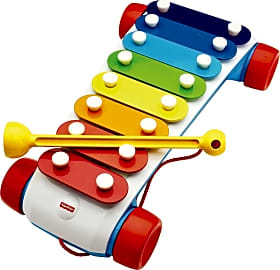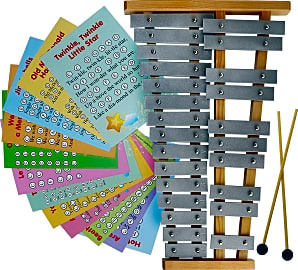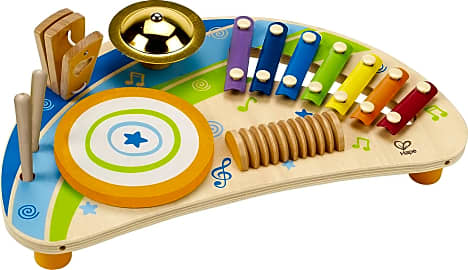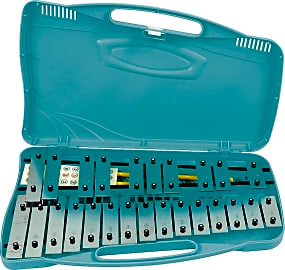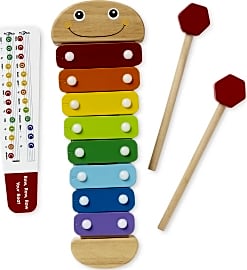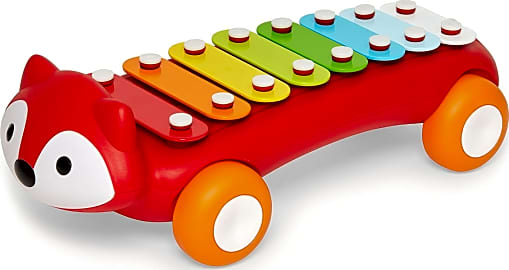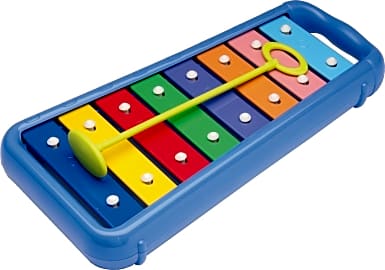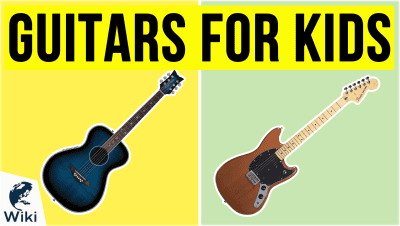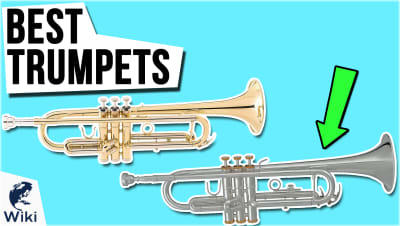The 10 Best Kids Xylophones

This wiki has been updated 42 times since it was first published in February of 2016. These kids’ xylophones provide an entertaining and educational way to introduce youngsters to the world of music, and they just might inspire a lifelong love of it. Our selection includes models with vibrant color schemes, friendly animal themes, and instructional cards. They can help promote dexterity and hand-eye coordination, and are also great for teaching cause and effect. When users buy our independently chosen editorial picks, we may earn commissions to help fund the Wiki.
Editor's Notes
August 22, 2020:
Like children’s pianos and guitars, these kids’ xylophones come in a range of designs suitable for babies through tweens who learn an instrument for school. To round out the list in this update, we added in another model geared toward older kids. The InTemenos Glockenspiel is geared toward those ages six and up, and features a solid wooden frame and keys with corresponding notes that span two octaves from G to G. Unlike some others, this one comes with 12 cards for teaching kids to play classic songs like "Old MacDonald," "Twinkle Twinkle Little Star," "Jingle Bells," and more. It features a solid wooden frame and smooth metal keys. We also added in a couple of colorful models geared toward little tikes. The Hape Pound & Tap features a top with three vibrant balls that can be rolled on the keys underneath for a fun series of musical notes. Or, youngsters can remove the xylophone underneath to tap on it with the included mallet. We also added in another award-winning toy from the same manufacture, the Hape Mighty Mini Band. This one incorporates a drum, a cymbal, a guiro, a xylophone, and a clapper, so kids can experience a bevy of percussion instruments. These three models replace the Trophy Grover, which is basically a duplicate of the highly portable Lyons AX-25N2, the Liberty Imports Rainbow, which some users report is too flimsy of a design, and the VTech Zoo Jamz, which contains small parts and isn’t intended for children under three year of age.
We kept the thoughtfully designed A Great Life Harmonious in the top spot, thanks to its well-tuned construction, brightly colored keys, and quality wooden mallets. It also includes a sheet of music and a bonus carved eagle whistle. The list wouldn’t be complete without the classic Fisher-Price Classic, which many parents remember fondly from their own childhoods. Its recent redesign lends it a sleek, slightly curved shape. Its mallet is conveniently attached, which allows children to pull it on its smoothly rolling wheels, and the cord is short enough so as not to pose as a choking hazard.
No matter which children’s xylophone catches your eye, be sure your child falls within the manufacturer’s stated age range, and always supervise your child during playtime for safety’s sake.
April 04, 2019:
We included xylophones for every age from toddler to tween, so there are some plastic choices that aren't perfect pitch, but just engaging for little ones and a few for the more serious musician.
A Great Life Wooden is ranked first because it is designed to last with engaging colorful keys for younger learners, but high-quality wooden mallets and accurately pitched notes for older children with a real interest in music.
The VTech Zoo Jamz plays it's notes more like a piano, but kids can strike them with the included mallet. It's a good choice for more timid toddlers who may not make up tunes on their own.
Special Honors
Yamaha YX230 This model is great for students, thanks to its easy playability and handling. It sports a compact, lightweight design and requires no assembly. Its range spans three octaves, which is well suited for school instruction and performance. A built-in handle makes it easy to be carried by one person. Its frame sports rubber feet and is easy to store upright in a compact space. Included are a cover and mallets, and the corresponding X-stand and soft-side case are sold separately. yamaha.com
A Great Education Starts With Music
Even the very things that keeps us alive on a daily basis — our hearts beating and our lungs breathing — follows a rhythmic pattern.
Humans are rhythmic beings. We live our daily lives in accordance with the immediate rhythm of sunrise and sunset, the more drawn out rhythms of the planet revolving around our sun, and even, as some philosophers argue, through the rhythm of life oscillating to death and back again. Even the very things that keeps us alive on a daily basis — our hearts beating and our lungs breathing — follows a rhythmic pattern. It makes sense, then, that we would be musical beings, as rhythm and music are inseparable.
Music stimulates the brain in incredible ways, eliciting emotions and sparking curiosity. And learning how to harness the power to make music is one of the most empowering experiences a person can have. And like many formative experiences, it’s best absorbed by a young and hungry mind.
This is why youth music education is so important, though I don’t mean to say that a child has to have a study in music theory be educated. Banging on a set of pots and pans is a form of music education. And learning to play a more specific instrument shows kids a patterned way in which manipulating their environment can create art and allow themselves to be expressive. You can add the theory eventually, and it will take the experience to the next level, but at the outset it’s important to let children discover the natural phenomenon of musical expression.
A kids’ xylophone is a perfect tool for this kind of early music education. It will form immediate associations in the child’s mind among color, size, and sound. That’s because the nature of the xylophone is such that the larger metallic bars consistently produce lower pitch tones than the smaller bars. No matter how hard your kid strikes them, or even if they disassemble the entire instrument, this fact will remain. And many manufacturers color their bars to add an additional level of association.
It’s those early experiences of association that make learning an instrument of any kind such a vital tool for the developing mind. It will open up new cognitive pathways that will allow for greater metaphorical thinking, problem solving, and even emotional articulation. In short, it has the power to make your child a better learner and a better communicator.
How To Choose The Right Xylophone For Your Child
When it comes time to choose a xylophone for your child, there are a few important features to think about so that you get a toy that sees a lot of joyful use. Many of these will have to do with your child’s specific age, while others will have more to do with his or her personality.
Very young children will do just fine with a simple, yet colorful option.
Very young children will do just fine with a simple, yet colorful option. These often come with some kind of animal theme or with a more traditional wooden housing. They are usually small enough and light enough for a child to carry around with them, and some even have wheels and handles to make it easier for them to haul from one room to the next.
Interestingly, many manufacturers color the bars on their xylophones in accordance with the colors of the rainbow, often coincidentally matching the tones that have longer waveforms with colors that also have a longer waveforms. For example, the larger keys, which are the lower frequencies, will appear red or orange, colors that are also of a lower frequency than the blues, purples, and whites that populate the opposite end of xylophone where the higher frequency tones are played. This may begin to provide more perceptive children with an unconscious understanding of the relationship among frequency, color, and sound that they will eventually encounter in science class.
If your child is a little older, or if they have just shown an aptitude for music, there are more advanced models available, some of which even come with holders for sheet music. Many models designed for older or more advanced children will also be made from more durable materials and come in carrying cases that will protect the unit as he or she takes it to school or to a lesson.
How To Get Your Child Interested In Music
There are countless stories of children being forced into arts or sports in which they never really took a genuine interest. Parents hold a lot of sway over their children, and it can be easier than many parents intend to accidentally force a child to engage in something they really don’t want to do, simply because you, the parents, are passionate about it. Music is one such venture.
There are countless stories of children being forced into arts or sports in which they never really took a genuine interest.
The worst thing you can do is to sit your child down in front of their new xylophone and force them to play with it. They’re more likely to build up a long-term resentment than a lifelong appreciation for music. Fortunately, there are things you can do to help suggest that they play with it, and to encourage them without being prescriptive.
The best thing you can do for your kid’s interest in music or the arts is to make them available to them in may forms. That means getting a small xylophone, but it also might mean investing in a toddler piano, kids’ drum set, and the tools of other disciplines like an easel and paints or clay and playdough for sculpting. Part of the idea is to associate creative expression with playtime.
Kids also love to imitate their parents, so if you spend time making music and creating art, there’s a good chance that they’ll give it a go as well. You can use their materials to help reassure them that they’re safe and fun if your kid is a little more skittish about new adventures, or you can use the adult versions right alongside them if he or she is more the pure and energetic imitator. And if the xylophone or piano begins collecting dust after a few years, try not to convey any palpable disappointment. You don’t want them picking it back up just to please you. Trust that you did what was necessary to lay the groundwork for when they get a little older and realize how cool it is to be in a band.



